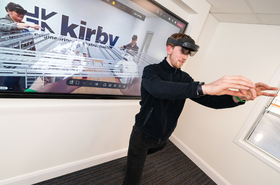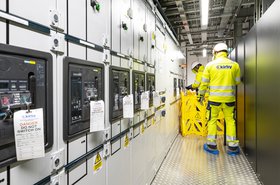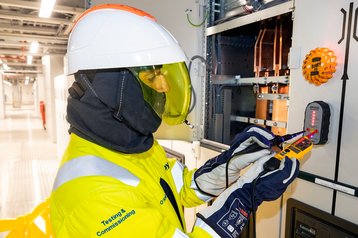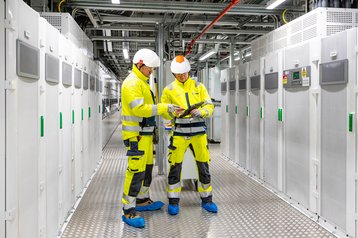What a difference a year can make. In Summer 2022, the data center sector was grappling with multiple different supply chain issues – largely, but not entirely, down to the economic hiatus wrought by the global response to Covid. But during 2023, with these issues rapidly easing, data center operators cannot build big enough and fast enough.
Yet if the infrastructure falls short in any way, the ribbon on the front door of the data center can remain uncut until the issues are solved.
That’s where a robust data center commissioning processes and team come in.
“Commissioning is not about coming in at the end of a data center project, turning everything on and preforming live testing. It starts before the construction has even kicked-off; almost at tender stage. The purpose is to ensure that the client’s specifications are met, and that the project meets the regulatory requirements,” says Alan Driver, testing and commissioning manager at Kirby Group Engineering.
“We test, start up, commission and hand over the systems to a really high standard. So the purpose is to ensure that we offer our clients a high value and trusted system.”
By being involved right from the start – the planning stage of the data center – Kirby can ensure that everything checks out so that all stakeholders are aligned behind the project commissioning implementation plan.
Exceeding standards
Like all the hardware installed in the data center, commissioning is standards-based: following the commissioning processes and procedures established by ASHRAE. However, in addition to the detailed commissioning protocols and processes it has developed based on ASHRAE, Kirby has also written a few extra chapters.
For example, a project typically goes from levels one through to five commissioning stages, Kirby starts at level zero with its ‘design qualification’ process.
“There’s a huge number of compliance regulations and standards that have to be reviewed at the pre-construction stage, which we call ‘level zero commissioning’. That means design qualification, whereby we take a tender and the design, and turn it over to make sure that it’s compliant with local standards and project specifications.
“That is to say, with electrical, fire and mechanical systems; then signed off by our specialists to certify that the design qualifies under level zero commissioning. That means that we’re ready to go to the procurement stage and start ordering all of the equipment and materials,” says Driver.
This stage is invaluable as the scrutiny by a third party ensures that the equipment and hardware will work well together when it turns up on site.
The importance of confident, early procurement has been demonstrated in recent years with the hiatus in supply chains wrought by semiconductor supply issues and the global response to Covid, followed by the inflationary wave that meant that prices could barely be guaranteed from one month to the next, let alone a year in advance.
Kirby uses critical path sequencing to stay on top of any supply chain issues that may crop up. This methodology is intended to identify the processes and supply of products that could cause delay, and to highlight the potential for delays so that they can be managed and mitigated early on.
Formally, in the commissioning process, level one is factory testing. In the past, this would’ve entailed specialists from Kirby paying a visit in person to the factories across the world in order to conduct that testing.
However, during Covid, Kirby implemented a system of virtual testing to make it easier to perform the tests that need to be conducted. “We can now execute our factory witnessing and acceptance testing virtually to aid with our equipment factory acceptance criteria.
“Let’s say the factory is located in Asia. We don’t have to send our engineers there, we can set up cameras around and within the equipment and they can all login and witness this factory testing remotely,” says Driver.
Obviously, that’s beneficial from an environmental point of view, but it also ensures efficiency and the best use of our engineers’ time.
Moreover, the results of the level one commissioning are inputted directly into Autodesk BIM360 software, which will contribute to the facility’s building information model (BIM) – the electronic manual that documents the building, how it was built and how it operates.
“Every item of equipment that we’re going to commission on a project will have an asset number. Each asset has dimensions, criteria with regard to where it fits into the overall drawings and 3D modelling of the building. Our engineers model and coordinate our drawings of the equipment right down to millimetres of where it will be positioned within that model.
“Then all of our electrical and mechanical services can be coordinated and integrated into that single model accordingly,” says Driver.
Using BIM in this way ensures that all of the technical details are unified, that everyone is following the same information, and ensures every detail is captured for the benefit of the client.
Going in
Once factory testing is successfully concluded, the equipment is shipped to site, positioned and then undergoes a receipt validation process before being level one (L1) tagged as a major milestone. Kirby engineers can then see that it has successfully undergone and passed factory testing and level one Commissioning, and the cabling, busbar and pipework construction phase commences.
“Once all our services are installed they go through a rigorous QA/QC inspection and testing process on-site, and upon passing this stage is awarded a L2 Tag completion milestone, which is a major achievement during the build, and that’s level two commissioning completed,” says Driver.
Level three commissioning is where all the systems are individually safety tested. “That’s where we engage all of our ‘energy marshalling’ team. What they do is manage all of our electrical and mechanical safe systems of work, our lockout/tagout (LOTO) programs, permit to work systems, and live hazardous energy works like switching high voltage switchgear,” says Driver.
This is arguably the most dangerous part of any data center project, where power is introduced, stage by stage, in line with the power cascade. Cooling systems will be flushed and pressure tested to ensure they are completely watertight, UPS systems will be energized and load tested, backup generators fired up, and power applied across high-voltage, ring-main systems.
The most hazardous testing involves the electrical systems to ensure that they are installed correctly, work as specified and will operate safely at maximum capacity.
“We carry out load testing, which we call burn-in testing or stress testing, of the busbar and the power distribution network. We bring in resistive load banks to simulate an actual full load capacity of the data halls, with large banks of resistance to ramp-up the current on these busbars to 100 percent capacity and sometimes even further.
“So if the busbar was, say, rated at 6,000 amps, we’d bring it up to 6000 amps incrementally and hold it there for a minimum of 30 minutes. Then we would deploy a commissioning team in full ARC flash PPE to thermal image all of the different components on that system to determine any hotspots, right back to the source on that particular string under test,” says Driver.
Data centers across the world use busbars to distribute power throughout the facility. They’re joined together and, on one run, there could be anywhere between 20 or 30 joints, each representing a particular potentially dangerous point of failure.
“We thermal image each of these joints, which means that our authorized person (AP) will gown up in arc-flash protective gear – effectively, bomb suits – to protect them in case there’s a fault during the stress test,” he adds. That can happen through sub-par installation, the unexpected failure of manufacturing components.
At this stage, therefore, it isn’t just the equipment undergoing a stress test.
A pass on these tests during level three commissioning merits an upgrade from L2 to L3 tag completion for the individual systems, meaning that the equipment has achieved Kirby’s safety criteria, and level four and five functional commissioning can commence.
Level four commissioning is where the systems are individually performance tested in the data center. This involves for example redundancy testing, whereby the mains to the building is switched off to ensure generators kick-in and cooling systems continue, unaffected. Different performance criteria will be developed and monitored for each system, including fire alarms and other safety monitoring systems.
“Then the final test is level five, which is the integrated system testing,” says Driver.
The individual instruments have been tested and tuned, and now it’s time for the orchestra to play together for the first time.
This will include blackout tests in which power to the building is shut off. “We need to be sure that all of our alarm signals, control signals and backup power systems operate within the anticipated parameters,” says Driver.
“As with all of our tests throughout commissioning, we’ll have a ‘script’ of how they are meant to operate under these conditions and we’ll note what we actually witness operating. If it doesn’t perform as we expect then we’ll go back, fix the issues and retest.
Once level five commissioning is complete, the project is completed.
No surprises
Kirby’s thorough formula for commissioning reflects its ‘no surprises’ approach to project management, as detailed by Ronan O’Neill, associate director – planning and project risk, in a feature with DCD earlier this year. “Each operational support department is required to deliver upon three core elements: service, consultancy and governance,” he told DCD.
Kirby’s detailed standard operating procedures (SOPs) and processes were developed to ensure consistency and “no surprises”.
O’Neill continued: “These SOPs highlight the company’s collaborative approach, both internally and with external stakeholders, and how project risk is identified, assessed, communicated, and escalated. Depending on the nature and severity of the risk event, no matter the project or region, within 30 minutes the managing director will be informed.”
After all, the modern data center is one of the most sophisticated buildings in the modern world – the cathedrals of the information age.
Indeed, few people appreciate just how sophisticated it is than the electrical and mechanical specialists who turn these vast buildings, not just into multi-megawatt server halls, but safe and efficient multi-MW facilities that keep businesses running, movies served and games played worldwide, every second of every day.
More...
-

Looking at construction through technology
Kirby tells us about the new technologies they use to improve construction
-
![Kirby preferred image_DSB02044[145153].jpg](https://media.datacenterdynamics.com/media/images/Kirby_preferred_image_DSB020441451.2e16d0ba.fill-280x185.jpg)
Sponsored Data center supply chain challenges: It’s good to talk
Managing complex supply chains today requires diligence and hard work to bring data center builds in successfully and on-budget, advises Kirby procurement specialist David Waldron
-

Sponsored Delivering predictable results in unpredictable times
Kirby prides itself on its ‘no surprises approach’ to projects, backed up by thorough planning with all stakeholders from pre-construction all the way to commissioning



